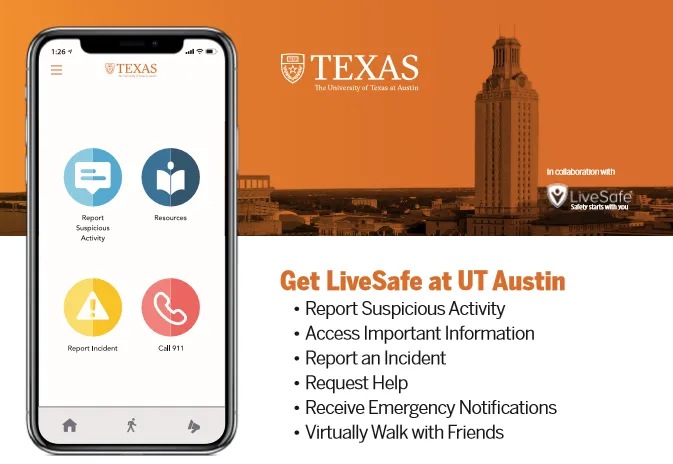Part of the student experience at UT Austin includes learning safe practices that can be used on campus and beyond. Through a variety of programs and communications, students learn how to take action for their personal safety and property and how they can encourage a culture of safety on campus. Campus safety is the University’s highest priority.
For a more extensive list of UT Austin campus safety and security resources, please visit utexas.edu/campus-life/safety-and-security.

What is being done to keep students safe?
The University of Texas at Austin Police Department (UTPD) is a fully-functioning, accredited state police agency that employs more than 100 sworn officers to serve the UT community 24 hours a day. UTPD includes an investigative division, K-9 teams, bicycle teams and its own 911 dispatch center.
The department operates on a community-oriented policing philosophy, encouraging greater communication between police and the communities they serve. Members of the UT community are encouraged to use the District Representative interactive map to directly email an officer about any concerns.
- All incoming students are required to take risk prevention programs, AlcoholEdu and the Sexual Assault Prevention Program: healthyhorns.utexas.edu/AlcoholEdu/index.html
- Counseling and Mental Health Services – Provides counseling, psychiatric consultation, and prevention services: cmhc.utexas.edu
- All building major access points include first aid stations.
- West Campus Ambassadors is a program with Safety Ambassadors who are an onsite presence between 7:00 a.m. and 3:00 a.m. on foot and bicycle, and by truck, sharing safety resources and tips, escorting residents to their destinations in the late evening, monitoring the region for unwanted activity, discouraging panhandling, working with local law enforcement to address other problematic situations, and serving as another set of eyes in the area. Learn more about them at https://wcambassadors.org/.
- The “Your ID is Your Key” initiative restricts building access during specific times only to students, faculty and staff with university ID cards or traditional keys.
- Main entrances on all campus facilities are clearly defined and enhanced with approach-way lighting, electronic access control and video interface.
- Main entrances of every academic and general-purpose classroom building are outfitted with a “safety hub” that includes an automated external defibrillator (AED), hemorrhage control kits, and an emergency call box connected to the UTPD Dispatch Center.
- Every classroom displays an emergency guide that provides instructions for certain emergency situations and includes the building address and room number for that location in case someone should need to call or text to 911.
- While UTPD and the university do a great deal to provide a safe environment, it requires participation from the community to be fully effective (e.g., call 911, report theft or suspicious activity, offer suggestions, etc.).
- The free LiveSafe at UT Austin app allows users to instantly engage in a text conversation with UTPD 911 dispatchers and send photos or video should they encounter suspicious activity. Within the app is a Virtual Walk feature that allows users to invite contacts to follow their travels whether walking or in a vehicle.
How will students be notified of emergency situations on campus?
The University has multiple ways to communicate with students in the event of a campus emergency. All systems are tested monthly to provide familiarity to students:
- Text alerts
- Used to communicate a credible, immediate, ongoing threat to campus.
- Alerts provide immediate direction to students, faculty and staff with specific actions to take.
- Students are automatically enrolled for alerts when they register for classes with the University. They are enrolled with the cell phone the University has on file. If they change their cell phone number, they must update their account with the new phone number.
- Emails
- Used to communicate crimes and incidents on and immediately near campus.
- Emails provide details and updates that can aid in the prevention of similar incidents.
- Students automatically receive email notifications.
- Outdoor Warning Siren
- Activated in the event of certain emergencies, such as severe weather, that require people to seek shelter immediately.
- Social Media and Emergency Website
- Twitter: @UTAustinPolice, @UTAustin and @AustinPolice
- Facebook: UT Austin Police, The University of Texas at Austin
- emergency.utexas.edu
How can students create a safer campus environment?
You can play a key role in creating a safe campus community by:
- Becoming familiar with the UT Austin campus safety and security information: utexas.edu/campus-life/safety-and-security.
- Call 911 whenever you feel unsafe. 911 is the fastest way to get help during police, medical or fire emergencies.
- Walk in pairs or groups. You are safer together.
- Be aware of your surroundings at all times. Put your phone down and keep your eyes and ears on what is happening around you.
- Developing a peer and family emergency communication plan. Whether an emergency occurs on campus or in your hometown, establish a concrete two-way communication plan so you everyone knows what is happening.
- Use the University’s safety resources:
- SURE Walk provides students with a safe escort home via an accompanied walk, golf cart or vehicle every day from 8 p.m. to 2 a.m. during the fall and spring terms. Students can call 512-232-9255.
- Students can request a ride from UTPD when SURE Walk is not operating, by calling 512-471-4441, selecting 9.
- UT Night Rides provides free Lyfts away from main campus to your home seven days a week from 12 a.m. to 4 a.m. Locations served mirror current UT Shuttle System routes. All rides must originate from main campus only.
- Behavior Concerns Advice Line (BCAL), 512-232-5050 is a 24/7 advice line anyone can call to discuss their concerns about a student, faculty or staff’s behavior with trained staff.
- Review the Active Shooter Response Guide which also includes a video.

